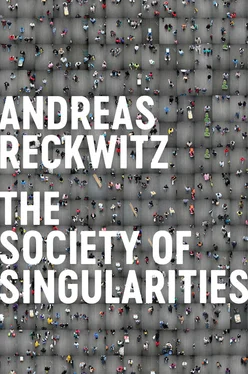What should we think about the relation between the three aforementioned configurations of the particular – again, the general-particular, idiosyncrasies, and singularities? It can be maintained first of all that the distinction between them should lead to more than just a classification – it can also help to analyze their interrelations. In all three cases, at any rate, we are dealing with real configurations in the social world. The social logic of singularities exists , as does the social logic of the general (with its production of the general-particular) as well as the population of idiosyncrasies, which may not be part of any social logic but exist nevertheless (in the manner of “things in themselves”). What is interesting is that these three spheres are not closed off from one another but rather share a dynamic relationship of translation and exchange, especially in late modernity. 11
Idiosyncrasies can thus transform into singularities when previously unrecognized unique features are socially recognized for their uniqueness – when, for instance, a computer specialist with all his quirkiness is elevated to a nerd, or a formerly unacknowledged and seemingly worthless object is suddenly regarded as a work of art. Every idiosyncrasy has the potential to become a singularity. Conversely, as already mentioned, singularities can (if only temporarily) become part of the register of the general-particular at the moment when someone attempts to make their presumably incomparable qualities comparable or even gradable (for instance, in analyses of art or religion, in the quality rankings of films, etc.). Beyond that, it is possible for previously merely functional goods from the register of the general to be singularized (the mass-produced plastic chair, for example, advanced to become the singular Eames design) if a degree of inherent complexity is discovered in something that otherwise bears general features, as a result, for instance, of heightened cultural sensitivity or the development of more discerning tastes. Finally, singularities can lose their character as valuable entities, become de-singularized , and sink to the status of unnoticed idiosyncrasies (as when religions cease to be practiced or works of art cease to be recognized as such). As we will see more clearly later on, the rising significance of the social logic of singularities in late modernity owes a great deal to the fact that idiosyncrasies – but also examples of the general-particular – can transform into singularities. At the same time, the transformation of general-particular parameters into singularities has also gained significance, with the result that a broad spectrum of singularities has been cultivated by society and allowed to flourish.
It should have become clear from the foregoing discussion that a sociological analysis of singularities requires a sophisticated heuristic. Although I have already pointed out that the familar semantic complex of individualism, the individual, individualization, and individuality – to which sociology used to refer – is not especially helpful to this sort of analysis, I should at least explain why this is so. 12One central problem is the widely variable meaning of these concepts and thus their unclear reference to the sphere of phenomena associated with the particular. Depending on who is using them, the terms individualism and individuality can designate extra-social idiosyncrasies or socially certified uniqueness or the particular within the framework of a general order. Sometimes the concept of individuality is used to denote idiosyncrasies. In other cases, these concepts refer to various facets of the individualism of equality, which was characteristic of classical modernity: to the equal rights that people have, to the equal worth that each person is ascribed, to the self-responsible and self-interested nature of certain activity – to every particular thing in the same way. Georg Simmel thus spoke of a modern and rationalistic individualism of the equal and general and juxtaposed it to the Romantic tradition’s individualism of the particular. 13Because we are concerned with the distinction between the social logic of singularities and that of the general, any concept that can unabashedly refer to both is, of course, out of the question.
That was the first problem with the concept of individualism: it is too broad and ambiguous. The second problem is that in other respects it is too narrow, and this is because it typically refers to human subjects alone. As I have already stressed on several occasions, however, it is paramount to keep in mind that the social fabrication of singularities is not restricted to subjects but rather encompasses all the other entities of the social named above: objects, spaces, temporalities, and collectives. A society of singularities cannot be understood if one remains fixated on the subject. 14
Objects, Subjects, Spaces, Times, and Collectives in the Social Logic of Singularities
It cannot be repeated enough that all five entities of the social, which I discussed above in connection with the social logic of the general, can become the object of processes of singularization, too: objects and things, human subjects, collectives, spaces, and temporalities. One important feature of the intersectional term “singularity” is that it makes it possible to describe and relate socio-cultural particularities from every social entity. This can be illustrated in brief with a few examples of characteristic forms of singularization from the past and the present.
All forms of society have regarded a select number of entities as singularized objects with their own complexity and density (surprisingly, this social tendency to singularize entities from the world of objects and things has received less scholarly attention than one might suppose). 15Paradigmatic examples of singular objects are material objects such as relics, other cult objects, and works of art such as paintings and sculptures, which only exist in one exemplar and to which Walter Benjamin famously ascribed an “aura.” 16Buildings, furniture, and items of clothing can likewise be perceived, produced, and valued as singular. To exist in just a single exemplar, however, is not a necessary precondition for singularity in the sense intended here. Even objects that have a variable or technically reproducible material basis can be singularized. This is true, for instance, of religious, literary, or philosophical texts, which are frequently certified as original by being attributed to an author, and it is also true of music, photographs, films, and political symbols. Theories, narratives, and images are singularities that circulate in a variety of media formats. 17
A specific example is the collection of various different objects under one identifiable brand , which is associated with the promise of uniqueness within the realm of cultural capitalism or with a particular aesthetic style . 18Entities of organic nature can also be singularized: house pets, gardens, or the desert and the Alps as particular places of biodiversity, for example. 19In every case, singularized things and objects are more than functional instruments; they either offer something in addition to that or they are exclusively cultural, affectively operating entities. As such, they are not stable throughout time but rather have their own object biographies. Generally, the elements and relations that constitute the inherent complexity and inner density of singular objects are highly diverse, and this is the case for obvious reasons. In this regard, materials, forms, and colors can play just as much a role as semantics, syntax, and the narrative, harmonic, melodic, or argumentative structures of texts, music, or theories. 20
As mentioned above, the fashioning of singular human subjects has traditionally been treated under the misleading rubric of individuality. Subjects are singularized when their uniqueness is socially recognized and valued and when they actively engage in and cultivate certain techniques that invite this recognition. 21In such cases, singularization means subjectification: the subject achieves an acknowledged degree of inherent complexity that defies typification (though this was and remains a possibility). 22Singularized subjects cannot be reduced to functional roles or hereditary groups. Magi, prophets, and rulers, to whom Max Weber ascribed the attribute of charisma, have traditionally been subjects who could claim to be inimitable. 23In modernity, artists and other creative people were the first to form milieus in which originality was both desired and demanded. 24
Читать дальше












